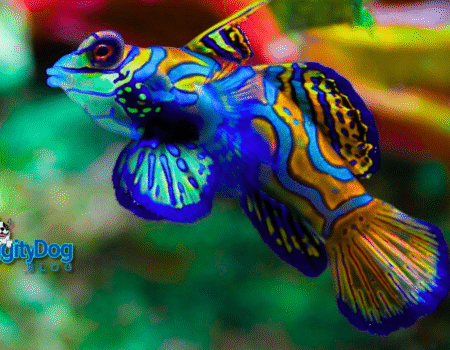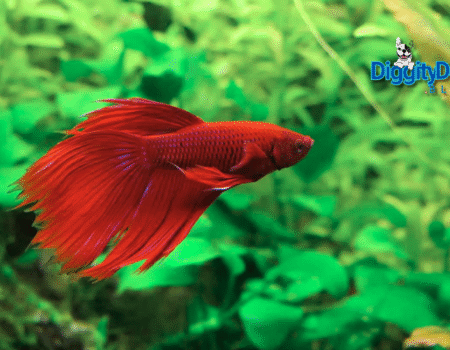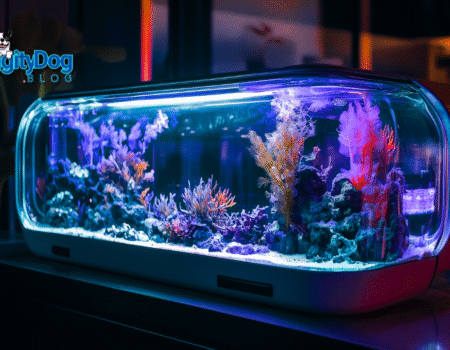Welcome to our fascinating journey into the world of clown fish. In this article, we will dive deep into the facts and wonders of these vibrant creatures that inhabit our oceans. Whether you are a seasoned diver, an animal enthusiast, or simply curious about marine life, this article will provide you with a wealth of valuable information on clown fish facts.
Key Takeaways:
- Clownfish are Type of Fish belong to the family Pomacentridae.
- They have vibrant orange color and three distinctive white bars.
- Clownfish form a unique relationship with sea anemones for protection and shelter.
- They have the ability to change sex during their lifespan.
- Clownfish can be found in tropical waters and coral reefs around the world.
Characteristics of Clownfish
Clownfish are bright orange with three distinctive white bars, making them easily recognizable among reef-dwelling fish. They are named after the sea anemones in which they make their homes. Before settling in an anemone, clownfish perform an elaborate dance, gently touching the anemone’s tentacles with different parts of their bodies. This dance helps them become acclimated to their host. They have a layer of mucus on their skin that makes them immune to the anemone’s sting, providing them safety and food scraps in exchange for protection and parasite removal.
The Unique Relationship between Clownfish and Sea Anemones
Clownfish have a fascinating relationship with sea anemones, where both species benefit from each other’s presence. The clownfish seek refuge and protection within the tentacles of the anemone, as they are immune to its stinging cells. The anemone provides shelter and food scraps in the form of leftover prey that it catches. Furthermore, the clownfish help keep the anemone clean and free from parasites by eating them. This mutually beneficial partnership showcases the intricate balance of nature in the underwater world.
| Behavior | Description |
|---|---|
| Elaborate Dance | Clownfish perform a gentle dance before settling in an anemone, acclimating to its tentacles and establishing a symbiotic relationship. |
| Immunity to Stings | Clownfish have a layer of mucus on their skin that makes them immune to the stinging cells of the anemone, providing them safety. |
| Protection and Food | The anemone provides shelter and food scraps to the clownfish in the form of captured prey. |
| Parasite Removal | Clownfish help keep the anemone clean and free from parasites by consuming them. |
Habitat and Range of Clownfish
Clownfish are fascinating creatures that thrive in specific habitats. They are primarily found in the shallow waters of the Indian Ocean, the Red Sea, and the western Pacific. Unlike their relatives, they are not found in the Caribbean, Mediterranean, or Atlantic Ocean. To find their ideal living environment, clownfish prefer to reside in close proximity to sea anemones, which serve as their homes and offer protection from predators.
Clownfish are well adapted to coral reefs and other marine environments that are rich in biodiversity. These vibrant reef-dwelling fish can be found among the intricate structures of coral reefs, where they find ample food sources and shelter. Their habitat choice allows them to take advantage of the diverse ecosystem and ensures their survival in the vast ocean.
The unique relationship between clownfish and sea anemones is a crucial aspect of their habitat. The clownfish seek protection within the tentacles of the anemones, utilizing their mucus coating to prevent the anemone’s stinging cells from harming them. In return for this sanctuary, the clownfish provide food scraps to the anemone and aid in parasite removal, creating a mutually beneficial partnership.
Clownfish Habitat Characteristics:
- Coral reefs
- Shallow waters
- Indian Ocean, Red Sea, and western Pacific
- Close proximity to sea anemones
- Rich biodiversity
By selecting their habitat carefully, clownfish have thrived in these warm, tropical waters, showcasing their remarkable ability to adapt and coexist in harmony with their surroundings.
“The vibrant colors of clownfish residing in coral reefs create a stunning visual spectacle, adding to the beauty and diversity of these intricate marine ecosystems.”
Clownfish Diet
When it comes to their diet, clownfish are carnivorous creatures with an opportunistic feeding behavior. They have a diverse palate and consume a range of prey, including plankton, mollusks, crustaceans, and even dead anemone tentacles. However, their dining habits go beyond just hunting for food. Clownfish have a unique relationship with their host anemones, where they reap the benefits of the anemone’s ability to capture and consume larger prey.
The symbiotic partnership between clownfish and anemones provides a constant supply of food for the fish. Clownfish scavenge for food within their habitat and also take advantage of food scraps left behind by their anemone hosts. This mutually beneficial relationship ensures that the clownfish have a steady source of nourishment while helping the anemones by removing parasites and providing protection.
It’s important to note that clownfish are not predatory fish themselves. Instead, they rely on their scavenging behavior to find sustenance. By foraging near their anemone homes, clownfish also minimize the risk of becoming prey to larger, more aggressive predators in the ocean.
Explore the table below for a breakdown of the clownfish diet:
| Prey | Description |
|---|---|
| Plankton | Microscopic organisms drifting in the water column |
| Mollusks | Invertebrates with soft bodies, such as snails and clams |
| Crustaceans | Marine arthropods, including shrimp and crabs |
| Dead anemone tentacles | Consuming decaying parts of the anemone benefits both the clownfish and the anemone host |
By diversifying their diet, clownfish ensure they obtain the necessary nutrients for growth and survival. Their omnivorous feeding habits allow them to adapt to varying environmental conditions and minimize competition for limited food resources.
Clownfish Reproduction
Clownfish have a fascinating reproduction system that sets them apart from other fish species. One of the most remarkable aspects of their reproductive behavior is their ability to change sex. All clownfish are born male, but when the dominant female dies, the dominant male undergoes a remarkable transformation and becomes the new female. This sex change is irreversible and ensures the continuation of the clownfish population.
To start the reproductive process, clownfish engage in a spawning ritual. The female lays eggs on a flat surface near their host anemone, carefully choosing a suitable location. Both parents play an essential role in raising the offspring. They diligently guard the eggs and fan them with fresh water to ensure proper oxygenation. This attentive care helps to increase the chances of survival for the developing embryos.
The spawning process usually occurs after dark to reduce the risk of predation, as many nocturnal predators are less active during this time. This strategy allows the clownfish offspring a better chance of survival during their vulnerable early stages.
Clownfish reproduction is a fascinating and unique process that showcases their remarkable adaptability and parenting skills. The combination of sex-changing ability, careful selection of egg-laying sites, and dedicated parental care contributes to the success and survival of these captivating creatures.
Clownfish Species
There are at least 30 known species of clownfish, each with its own unique characteristics and habitat preferences. Some notable species include:
- Amphiprion percula: Found in the Indian Ocean and Pacific Ocean.
- Amphiprion ocellaris: Similar to the false clownfish.
- Amphiprion frenatus: Known as the tomato clownfish.
- Amphiprion clarkii: Distinctive black, white, and yellow stripes.
These species can vary in size, coloration, and patterns, but they all share the common traits of being clownfish.
“There are at least 30 known species of clownfish, each with its own unique characteristics and habitat preferences.”
Interesting Clownfish Facts
Clownfish, also known as anemonefish, are fascinating creatures with several intriguing facts that make them a unique species in the ocean. Here are some interesting clownfish facts:
- All clownfish are born male and have the ability to change sex to become a dominant female in a group. This sex-changing adaptation ensures the continuation of their species and helps maintain a balanced social structure within their communities.
- Clownfish have a symbiotic relationship with sea anemones, where they provide protection and parasite removal in exchange for food and shelter. The clownfish’s mucus layer protects them from the stinging cells of the anemone, enabling them to live harmoniously within its tentacles.
- Although clownfish are often associated with the movie Finding Nemo, the characters in the movie are actually false anemonefish, which are closely related to true clownfish. Despite the documentary inaccuracies, the movie helped raise awareness about these colorful reef-dwellers and their important role in the marine ecosystem.
- Clownfish can be found in warm tropical waters and are often seen in coral reefs and other habitats rich in marine life. Their vibrant orange coloration with white stripes serves as a warning to potential predators, indicating that they are venomous and should be avoided.
Now that we’ve explored these interesting facts about clownfish, it’s time to dive deeper into their conservation efforts and the amazing dive sites where you can observe them in their natural habitat.
| Interesting Clownfish Facts |
|---|
| All clownfish are born male and have the ability to change sex to become a dominant female in a group. |
| Clownfish have a symbiotic relationship with sea anemones, where they provide protection and parasite removal in exchange for food and shelter. |
| Clownfish have been popularized by movies such as Finding Nemo, but the characters in the movie are actually false anemonefish, closely related to true clownfish. |
| Clownfish can be found in warm tropical waters and are often seen in coral reefs and other habitats rich in marine life. |
| The vibrant orange color of clownfish serves as a warning to predators that they are venomous and should be avoided. |
Conservation of Clownfish
Clownfish, like many other marine species, face numerous threats to their survival. These threats include habitat destruction, pollution, climate change, and the aquarium and pet trade. The collection of many clownfish species for the aquarium industry has put additional pressure on their populations in the wild. Additionally, the demand for clownfish has also harmed their host anemones, which suffer when these fish are taken from their natural habitats.
Fortunately, local governments and conservation organizations have recognized the importance of protecting clownfish populations and their habitats. Restrictions on the collection of clownfish have been implemented to preserve their numbers and prevent overexploitation. These measures aim to safeguard clownfish and their ecosystems for future generations to enjoy.
Efforts are also underway to promote sustainable practices within the aquarium trade. By encouraging responsible sourcing of clownfish and supporting captive breeding programs, we can reduce the impact on wild populations while still allowing enthusiasts to enjoy these beautiful fish in home aquariums.
Conservation initiatives focus not only on clownfish themselves but also on their symbiotic relationship with sea anemones. Protecting the health and abundance of anemones is crucial for the long-term survival of clownfish. By conserving their habitats and raising awareness about the importance of these delicate ecosystems, we can contribute to the overall well-being of clownfish populations.
To summarize, clownfish conservation involves protecting their habitats, implementing restrictions on collection, promoting sustainable aquarium trade, and raising awareness about the importance of their symbiotic relationship with sea anemones. By taking these actions, we can ensure the continued presence of these enchanting and colorful creatures in our oceans.
Conservation Strategies for Clownfish
Conservation strategies for clownfish include:
- Implementing restrictions on the collection of clownfish
- Promoting responsible sourcing of clownfish within the aquarium trade
- Supporting captive breeding programs for clownfish
- Protecting the habitats of clownfish and their host anemones
- Creating marine protected areas to safeguard clownfish populations
- Raising awareness about the ecological importance of clownfish and their symbiotic relationship with sea anemones
Conservation Success: A Case Study
“The establishment of Marine Protected Areas has significantly contributed to the conservation of clownfish populations. By designating specific areas as protected zones, we have been able to limit human activities that harm these fish and their habitats. As a result, clownfish populations have shown signs of recovery, providing hope for effective conservation efforts.”
– Dr. Emma Collins, Marine Biologist
Conservation Efforts for Clownfish
| Conservation Action | Impact |
|---|---|
| Implementation of collection restrictions | Reduces overexploitation of clownfish populations |
| Sustainable sourcing of clownfish within the aquarium trade | Minimizes the impact on wild populations |
| Support for captive breeding programs | Reduces the demand for wild-caught clownfish |
| Protection of clownfish habitats | Preserves the ecosystems vital for their survival |
| Creation of marine protected areas | Safeguards clownfish populations from destructive human activities |
| Public awareness and education | Fosters understanding and support for clownfish conservation |
Dive Sites for Clownfish
Are you ready to embark on an underwater adventure and dive into the world of clownfish? You’ll be thrilled to know that these captivating creatures can be found in various dive sites across the globe, offering a truly exhilarating experience for diving enthusiasts. Whether you’re an experienced diver or a beginner, exploring the warm waters that clownfish call home is an opportunity you won’t want to miss.
1. The Pacific Ocean
One of the prime locations to spot clownfish is in the vast expanse of the Pacific Ocean. From the crystal-clear waters of Micronesia to the captivating reefs of Fiji and Palau, there are numerous dive sites that offer the chance to observe these enchanting fish in their natural habitat. The diverse marine life in the Pacific Ocean provides a mesmerizing backdrop for your underwater exploration.
2. The Red Sea
Another popular destination for diving with clownfish is the stunning Red Sea. Located between Africa and Asia, the Red Sea boasts vibrant coral reefs teeming with marine biodiversity. Dive sites like Egypt’s Ras Mohammed National Park and the Brothers Islands offer an excellent opportunity to encounter clownfish and marvel at the underwater wonders that this region has to offer.
3. The Indian Ocean
The Indian Ocean is a treasure trove of dive sites that are home to clownfish and an abundance of marine life. The Maldives, Seychelles, and Sri Lanka are just a few of the stunning destinations where you can immerse yourself in the beauty of the Indian Ocean and witness the magical dance of clownfish among the coral reefs.
4. The Great Barrier Reef
No mention of dive sites for clownfish would be complete without highlighting the iconic Great Barrier Reef in Australia. Stretching over 2,300 kilometers, this World Heritage-listed site is a dream come true for divers and offers an unparalleled opportunity to encounter an array of vibrant marine species, including clownfish. You’ll be captivated by the colors and diversity of this incredible marine ecosystem.
No matter which dive site you choose, diving with clownfish promises an unforgettable adventure beneath the waves. Their vibrant colors and playful behavior will mesmerize you as you witness their intricate relationship with their host anemones. Immerse yourself in their world and create lasting memories as you explore the underwater realm of clownfish.
Dive Sites for Clownfish – Top 4 Destinations
| Dive Site | Location |
|---|---|
| The Pacific Ocean | Micronesia, Fiji, Palau |
| The Red Sea | Egypt (Ras Mohammed), Brothers Islands |
| The Indian Ocean | The Maldives, Seychelles, Sri Lanka |
| The Great Barrier Reef | Australia |
Conclusion
The clownfish is an extraordinary creature that captivates both divers and non-divers with its vibrant colors and unique behaviors. Its symbiotic relationship with sea anemones adds to its allure, making it a true gem of the ocean. By understanding the clownfish’s characteristics, habitat, diet, and reproductive system, we can gain a deeper appreciation for these charismatic fish and work towards their conservation.
Clownfish are known for their bright orange color and distinctive white bars. They are named after the sea anemones that provide them with protection and a safe haven. Despite their venomous hosts, clownfish have developed a mucus layer on their skin that makes them immune to the anemone’s sting. In return for shelter, clownfish aid their hosts by removing parasites and providing food scraps.
These fascinating creatures can be found in the warm waters of the Indian Ocean, the Red Sea, and the western Pacific. Clownfish prefer living in close proximity to sea anemones, which are abundant in coral reefs and other marine environments. However, they are not found in the Caribbean, Mediterranean, or Atlantic Ocean.
With their opportunistic feeding behavior, clownfish feed on a variety of prey, including plankton, mollusks, crustaceans, and dead anemone tentacles. They scavenge for food in their habitat, benefiting from the anemone’s ability to capture larger prey. Clownfish also have a unique reproductive system, where they can change sex. All clownfish are born male, and when the dominant female dies, the dominant male changes sex and becomes the new female.
FAQ
What is a clownfish?
Clownfish, also known as anemonefish, are a type of fish that belong to the family Pomacentridae. They are known for their bright orange color, three white bars, and their unique symbiotic relationship with sea anemones.
What is the lifespan of a clownfish?
In the wild, clownfish have an average lifespan of 6 to 10 years.
How big do clownfish grow?
Clownfish can grow up to 4.3 inches in length.
What kind of behavior do clownfish exhibit?
Clownfish typically live in schools and have an opportunistic feeding behavior. They have a unique relationship with sea anemones, where they seek protection and provide parasite removal in exchange for food and shelter.
Where are clownfish found?
Clownfish are primarily found in the shallow waters of the Indian Ocean, the Red Sea, and the western Pacific. They prefer living in close proximity to sea anemones in coral reefs and other marine environments rich in biodiversity.
What do clownfish eat?
Clownfish are carnivorous and feed on a variety of prey, including plankton, mollusks, crustaceans, and dead anemone tentacles. They also scavenge for food scraps left by their anemone hosts.
How do clownfish reproduce?
Clownfish have a unique reproductive system where all individuals are born male. When the dominant female dies, the dominant male changes sex and becomes the new female. Clownfish reproduce through spawning, where the female lays eggs on a flat surface near their host anemone, and both parents guard the eggs until they hatch.
How many species of clownfish are there?
There are at least 30 known species of clownfish, each with its own unique characteristics and habitat preferences. Some notable species include Amphiprion percula, Amphiprion ocellaris, Amphiprion frenatus, and Amphiprion clarkii.
What are some interesting facts about clownfish?
Clownfish have the ability to change sex, they have been popularized by movies like Finding Nemo (though the characters in the movie are actually false clownfish), and their vibrant orange color serves as a warning to predators.
Are clownfish threatened in any way?
Clownfish face threats from habitat destruction, pollution, climate change, and the aquarium and pet trade. Efforts are being made to protect their numbers and preserve their habitat.
Where are some popular dive sites to see clownfish?
Popular dive destinations for clownfish enthusiasts include Thailand, Palau, Fiji, Indonesia, Malaysia, and the Philippines, where divers can observe clownfish in their natural habitat.










No Comment! Be the first one.